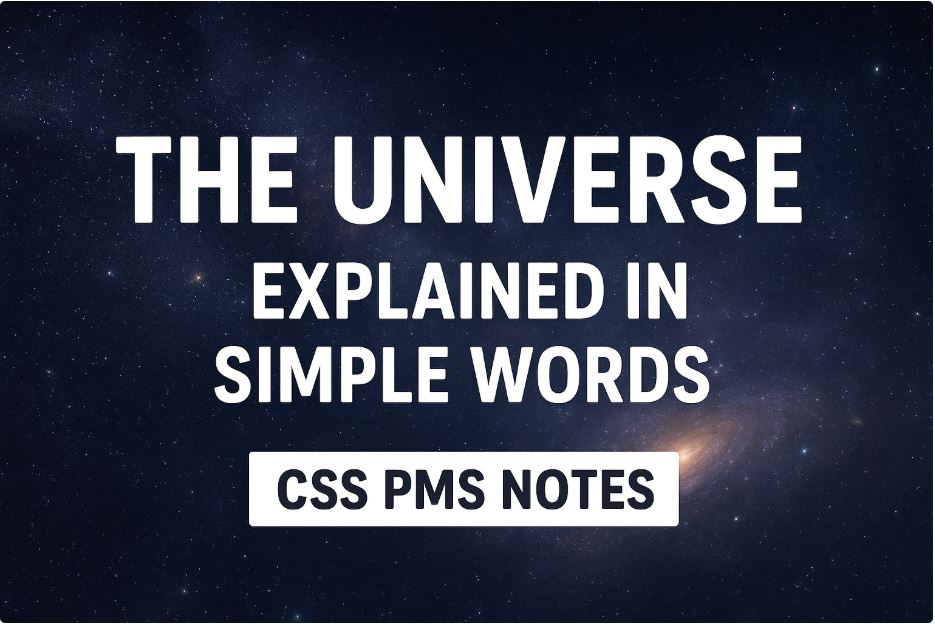The Universe — Explained in Simple Words

The Universe is everything around us — space, time, matter, and energy.
Every planet, every star, every galaxy, and even empty space belongs to the Universe.
Scientists say it started about 13.8 billion years ago. Yet, we still know only a small part of it.(Sources: NASA, Britannica, Live Science)
What Is the Universe?
The word Universe means “all that exists.”
It includes planets, stars, galaxies, dust, gas, and energy.
Even the space between them is part of the Universe.
| Feature | Description |
|---|---|
| Meaning | Everything that exists in space and time |
| Age | About 13.8 billion years |
| Studied in | Cosmology |
| Major Theories | Big Bang, Expansion of Universe |
Scientists use telescopes and satellites to study it.
Still, they say the Universe is mostly invisible to the human eye.
How Did the Universe Begin?
The Big Bang Theory
The most accepted idea about the birth of the Universe is the Big Bang Theory.
It says that the Universe began as a tiny, hot, and dense point.
Then, it expanded rapidly — creating space, time, and everything we see today.
The Big Bang was not an explosion in space.
It was an expansion of space itself.
After the Big Bang, particles formed atoms, atoms made stars, and stars created galaxies.
What Is Inside the Universe?
The Universe is not only made of things we can see.
Most of it is invisible and mysterious.
| Component | Percentage | Description |
|---|---|---|
| Dark Energy | 68% | Force that makes the Universe expand faster |
| Dark Matter | 27% | Invisible matter that holds galaxies together |
| Ordinary Matter | 5% | Everything we can see — stars, planets, humans |
That means we can see only 5% of the entire Universe.
The rest is hidden, and scientists are still studying it.
What Is the Observable Universe?
The observable Universe is the part we can see with telescopes.
Its radius is about 46 billion light-years.
That means light from the farthest galaxies takes billions of years to reach us.If the Universe were an ocean, the observable part would be only the surface.
Beyond that, space might go on forever.
How Are Stars and Galaxies Formed?
After the Big Bang, clouds of gas and dust gathered because of gravity.
These clouds became stars. Stars grouped together to form galaxies.Our galaxy, the Milky Way, has about 100–400 billion stars.
Stars live, shine, and die.
When they die, they explode — creating new elements like carbon and oxygen.
These elements form new planets and even life.Simple Points:
- Galaxies join together to make galaxy clusters.
- Every galaxy moves in space.
- Some galaxies are bigger than our Milky Way.
How Is the Universe Expanding?
Astronomer Edwin Hubble discovered that galaxies are moving away from each other.
This shows that the Universe is expanding like a balloon being blown up.Scientists found that this expansion is getting faster.
The reason is dark energy, which pushes galaxies apart.Did You Know?
Every second, the Universe grows larger everywhere — not from one point, but all over space.
What Will Happen to the Universe?
No one knows for sure how the Universe will end.
But scientists have three main ideas.
| Theory | What Happens |
|---|---|
| Big Freeze | The Universe keeps expanding until everything becomes cold and dark. |
| Big Crunch | Expansion stops; everything collapses back into one point. |
| Big Rip | Expansion becomes so strong that galaxies, stars, and atoms tear apart. |
These ideas come from studies of dark energy and the expansion of the Universe.
Why Understanding the Universe Matters
Studying the Universe helps us understand where we came from.
It also inspires science and technology — like satellites, telescopes, and space travel.
The Universe connects science and philosophy.
It reminds us how small we are, but also how important our questions are.
“We are a way for the Universe to know itself.” — Carl Sagan
Fun Facts About the Universe
- There are more stars in the Universe than grains of sand on Earth.
- Light from some stars takes millions of years to reach us.
- The Milky Way and Andromeda Galaxy will collide in about 4 billion years.
- Space is not empty — it is full of invisible dust, energy, and particles.
Summary
The Universe is vast, mysterious, and beautiful.
It began billions of years ago and is still expanding today.
We can only see a small part of it, but every discovery brings us closer to understanding how the Universe works.
The study of the Universe shows that everything — from tiny atoms to massive galaxies — is connected.